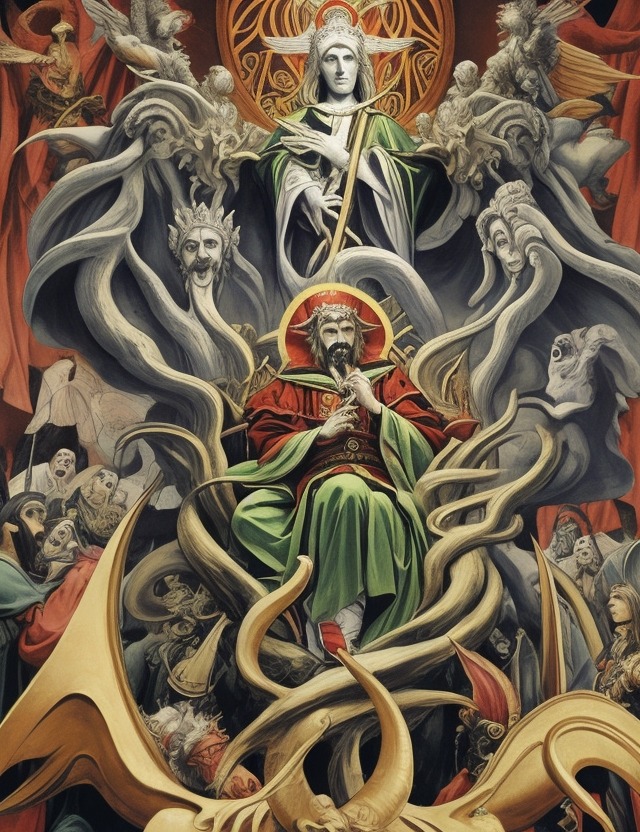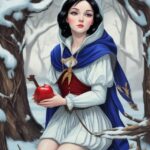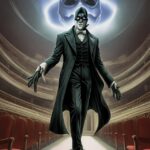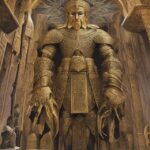Step into a world where allegory reigns supreme, as it author Dante Alighieri takes you on an unforgettable journey through the realms of Hell, Purgatory, and Heaven in his timeless classic masterpiece, The Divine Comedy. Considered one of the greatest works in world literature, this epic poem delves into the intricacies of the human condition, morality, and the afterlife. Drawing from historic data and rich symbolism, Alighieri crafts a tale that captivates readers even after centuries. In this article, we explore the depths of Dante’s profound narrative, revealing the hidden secrets and profound lessons that lie within its pages.
Whether you’re a literary enthusiast, a curious soul eager to explore profound themes, or simply seeking an enriching reading experience, join us as we uncover the fascinating universe of The Divine Comedy and its enduring impact on literature and human understanding. Prepare to be enthralled and enlightened, as we embark on this unforgettable adventure together. Divine Comedy Overview:
Divine Comedy by Dante Alighieri Summary
Divine Comedy with Dante. Once upon a time, there was a great writer named Dante Alighieri who lived in Florence, Italy. He was a brilliant poet and had written many beautiful poems. But there was one poem that would become his most famous and beloved work of all time, “The Divine Comedy.”
“The Divine Comedy” is a magnificent poem divided into three parts: Inferno, Purgatorio, and Paradiso. In this wondrous journey through the realms of the afterlife, Dante takes his readers on an adventure like no other.
Our story begins with Dante, the main character of the poem, finding himself lost in a dark and eerie forest. He feels fearful and confused, not knowing how he ended up in this place. Suddenly, a shadowy figure appears before him. It is none other than the great poet Virgil, who has been sent to guide Dante through his extraordinary journey.
Virgil tells Dante that he has been selected by divine intervention to travel through Hell, Purgatory, and Heaven in order to regain his path towards righteousness. Dante agrees to follow Virgil, and together they begin their descent into the depths of Hell.
As they venture deeper into the realm of the damned, Dante witnesses the horrifying punishments inflicted upon the sinners. He sees souls trapped in various circles, each representing a different sin. In the first circle, he encounters the unbaptized, who are in a state of eternal longing. In the second circle, the lustful are condemned to whirl around in violent storms. The third circle holds the gluttons, who are tormented by ceaseless hunger and thirst.
Continuing their descent, Dante and Virgil come across the wrathful and the greedy. In the fifth circle, they witness the heretics who deny the existence of an afterlife. In the sixth circle, they meet the violent, who are trapped in a river of boiling blood. In the seventh circle, the fraudulent receives their punishment, with hypocrites being weighed down by heavy robes and thieves chased by snakes.
Finally, in the deepest circle of all, Dante confronts the ultimate embodiment of evil, Satan himself. In a terrifying spectacle, Satan is depicted as a three-headed monster, each head chewing on a notorious traitor, including Judas Iscariot and Brutus. Dante and Virgil escape the bowels of Hell through a hidden path, leading them to Mount Purgatory.
As they ascend the mountain, Dante and Virgil enter Purgatory, a place of temporary punishment where souls cleanse themselves of their sins. Here, Dante encounters penitent souls who willingly undergo painful trials to reach their salvation. He meets souls being cleansed by fire, the envious forced to have their eyes sewn shut, and the proud forced to carry heavy stones.
Dante and Virgil make their way through each terrace of Purgatory, witnessing the transformation of souls from their sinful state to ones purified by suffering and repentance. Dante learns about the importance of love and humility, virtues necessary to progress further towards Paradise.
Upon reaching the top of Mount Purgatory, Dante’s guide changes to the beautiful and divine Beatrice, whom Dante passionately loved during his lifetime. Beatrice leads him into Heaven, where they ascend through planets, stars, and spheres, each representing different heavenly virtues.
Dante experiences the captivating beauty of Paradise and encounters the souls of illustrious characters who share their wisdom with him. He meets biblical figures, saints, and even his ancestor, Cacciaguida. They reveal to Dante the intricate wonders of the universe and the divine plan of salvation.
As they journey through the nine celestial spheres, Dante learns about the harmony of the cosmos, the importance of faith, hope, and love, and the ultimate bliss of being united with God.
Finally, Dante reaches the final destination, the Primum Mobile, the source of all divine light. Here, Dante experiences a vision of God himself and becomes one with the divine love. He is given a profound understanding of the intricate workings of the universe and the divine purpose behind all things.
“The Divine Comedy” is a remarkable tale that takes readers on an incredible journey through the realms of the afterlife. It teaches valuable lessons about the consequences of our actions and the importance of repentance, humility, and love. Dante Alighieri’s poetic masterpiece has captivated generations with its vivid imagery, powerful descriptions, and timeless messages of redemption and hope. So, dear children, be ready to embark on this magnificent adventure and let Dante’s words open your hearts and minds to the wonders of the divine. Divine Comedy Dante Summary.
The Divine Comedy Theme
The Divine Comedy is an epic poem written by Italian poet Dante Alighieri in the early 14th century. It is divided into three parts: Inferno (Hell), Purgatorio (Purgatory), and Paradiso (Paradise). Each part explores different realms of the afterlife and presents a vivid and allegorical journey of the protagonist, Dante himself. Here are three key themes depicted in The Divine Comedy:
1. The Nature of Sin and Divine Justice: The Divine Comedy delves into the nature of sin and its consequences. In Inferno, Dante descends into the nine circles of Hell, each representing a different sin and its corresponding punishment. Through detailed and graphic descriptions, Dante weaves a moralistic narrative, presenting a vision of divine justice. He emphasizes the idea that sinners ultimately face punishment in accordance with their deeds, reflecting the concept of retribution and the belief in an ordered universe.
2. Redemption and the Journey to Spiritual Salvation: Purgatorio serves as the transitional part between Inferno and Paradiso, wherein Dante encounters individuals undergoing spiritual cleansing on Mount Purgatory. This section highlights the importance of repentance, penance, and personal growth. Dante portrays the struggle and suffering necessary for individuals to purify their souls and attain salvation. It emphasizes the redemptive power of love and grace, pointing towards the possibility of spiritual transformation and the ultimate reunion with God.
3. The Power of Love and the Divine: The final part of The Divine Comedy, Paradiso, presents Dante’s ascent to Heaven and his encounter with celestial realms. This section explores the themes of divine love, beauty, and knowledge. It portrays the divine order, harmony, and perfection of God’s creation. Dante’s encounters with various saints, angels, and holy figures exemplify the different degrees of love and the sublime experience of being in the presence of God. The Paradiso emphasizes the ultimate goal of human existence – the union and communion with the divine.
In summary, The Divine Comedy is a profound exploration of sin, redemption, and the transformative power of love. It engages with fundamental concepts of morality, justice, and the nature of the divine in a compelling and allegorical manner.
The Divine Comedy Characters
1. Dante Alighieri: The main protagonist and narrator of the story, Dante is a renowned poet who embarks on a journey through the three realms of the afterlife – Inferno, Purgatorio, and Paradiso. He is depicted as an intellectual figure, dressed in dark robes, with a contemplative expression on his face. Fun fact: Dante has a weakness for a good slice of pizza, often daydreaming about his favorite toppings while navigating the treacherous realms.
2. Virgil: A classic poet hailed as the guide through Dante’s perilous journey, Virgil is a stoic and knowledgeable figure. He is described as stooped with age, dressed in a flowing toga, and carries a large book of ancient wisdom. Surprisingly, Virgil secretly loves cheesy romantic poetry and can recite sonnets about unrequited love at the drop of a hat.
3. Beatrice: Dante’s beloved and the symbol of divine love for him, Beatrice is a radiant beauty with flowing golden hair and bright blue eyes. She appears intermittently throughout the story, guiding Dante towards spiritual enlightenment. Little-known fact: Beatrice is an excellent cupcake baker and runs a secret bakery called “Divine Delights” in Paradiso, which supplies heavenly treats to the angels.
4. Charon: The ferryman of the Underworld, Charon is described as a grizzled old man with tattered robes and a brusque demeanor. He ferries souls across the river Styx, and wields a rather peculiar sense of humor. He enjoys telling dad jokes to keep the wayward souls entertained, and his favorite comedic routine involves puns about the River Styx being a “stylish” mode of transportation.
5. Lucifer: The ruler of Hell, Lucifer is depicted as an imposing figure with fiery red skin, bat-like wings, and multiple heads. He resides at the center of Hell, in a frozen lake called Cocytus, symbolizing his eternal isolation. However, beneath his fearsome exterior, Lucifer has an unexpected talent for ice sculpting and spends his free time creating intricate frozen masterpieces.
6. Cato of Utica: A historical figure who guards the entrance to Purgatory, Cato is depicted as a formidable warrior with a striking beard and a commanding presence. Despite his serious demeanor, Cato secretly loves knitting and is well-known amongst the souls in Purgatorio for his stylishly knitted scarves and socks.
7. Saint Peter: The gatekeeper of Heaven and the founder of the Catholic Church, Saint Peter greets Dante as he reaches Paradiso. He is described as a wise and benevolent figure with a flowing white beard and a radiant halo. Unexpectedly, Saint Peter is an avid salsa dancer and regularly hosts heavenly dance parties with angelic dance partners.
These unique descriptions aim to bring each character in “The Divine Comedy” to life, highlighting their physical features, their role in the story, and adding in some humorous and unexpected hobbies or talents.
The Divine Comedy: Symbols
1) The Three Beasts: In the beginning of The Divine Comedy, Dante encounters three beasts that block his path to reaching Heaven. These beasts symbolize sin and temptation: the leopard represents fraud and deceit, the lion represents violence and ambition, and the she-wolf represents incontinence and lust. These beasts represent the worldly sins and vices that Dante must overcome in order to progress on his spiritual journey towards God.
2) The Dark Forest: The Dark Forest represents the state of spiritual confusion and despair that Dante finds himself in at the beginning of his journey. It symbolizes the lost and sinful state of humanity, where people have strayed away from the path of righteousness and are unable to find their way back to God. The forest is a metaphor for the darkness and sin that humans encounter in their lives, and Dante must navigate through it to begin his journey of spiritual transformation.
3) The Mountain: As Dante progresses through the circles of Hell, he starts climbing the Mountain of Purgatory, which represents the process of purification and penance. The mountain symbolizes the path towards spiritual enlightenment and the progressive ascent towards God. Each terrace of the mountain corresponds to a specific sin and its corresponding penitential process. As Dante climbs higher, he sheds his earthly sins and becomes closer to God, eventually reaching the Earthly Paradise at the top of the mountain, which symbolizes the ultimate union with God. The mountain represents the journey of the soul towards moral and spiritual perfection.
The Divine Comedy Moral Lesson
The moral lesson of the Divine Comedy is that perseverance, determination, and piety are virtues that lead to success. The story follows the journey of Aeneas, a Trojan hero, who travels to Italy to establish a new home for his people. Along the way, he faces many challenges and obstacles, but he perseveres through them all with the help of the gods. The Divine Comedy teaches us that even in the face of adversity, we must remain steadfast in our beliefs and continue to work towards our goals.
Divine Comedy Levels of Hell
The Divine Comedy is an epic poem written by Dante Alighieri in the 14th century. The poem is divided into three parts: Inferno, Purgatorio, and Paradiso. The first part, Inferno, describes Dante’s journey through the nine circles of Hell, guided by the poet Virgil. Here are the circles or layers of Hell in order of entrance and severity:
- Limbo: Where those who never knew Christ exist. Dante encounters Ovid, Homer, Socrates, Aristotle, Julius Caesar, and more here.
- Lust: Self-explanatory. Dante encounters Achilles, Paris, Tristan, Cleopatra, and Dido, among others.
- Gluttony: Where those who overindulge exist. Dante encounters ordinary people here, not characters from epic poems or gods from mythology.
- Greed: Self-explanatory. Dante encounters more ordinary people but also the guardian of the circle, Pluto, the mythological king of the Underworld.
- Anger: Dante and Virgil are threatened by the Furies when they try to enter through the walls of Dis (Satan).
- Heresy: Rejection of religious and/or political “norms.” Dante encounters Farinata degli Uberti, a military leader and aristocrat who tried to win the Italian throne and was convicted posthumously of heresy in 1283. Dante also meets Epicurus, Pope Anastasius II, and Emperor Frederick II.
- Violence: This is the first circle to be further segmented into sub-circles or rings. There are three of them—the Outer, Middle, and Inner rings—housing different types of violent criminals.
- Fraud: Dante encounters various types of fraudsters, including panderers, seducers, flatterers, hypocrites, thieves, false counselors, sowers of discord, and falsifiers.
- Treachery: The final circle of Hell, where traitors reside. It is divided into four rounds, with each round reserved for a different type of traitor.
Why Divine Comedy is Called Comedy
The Divine Comedy is called a comedy because it has a happy ending. The poem is divided into three parts: Inferno, Purgatorio, and Paradiso. The first part, Inferno, describes Dante’s journey through the nine circles of Hell, guided by the poet Virgil. The second part, Purgatorio, describes Dante’s journey through Purgatory, where souls are purged of their sins before entering Heaven. The third part, Paradiso, describes Dante’s journey through Heaven, guided by Beatrice, his ideal woman. The poem is called a comedy because it is written in a style that is less serious than a tragedy, and because it has a happy ending. The adjective “Divine” was added later by Giovanni Boccaccio, owing to its subject matter and lofty style. The Divine Comedy is widely considered one of the greatest works of Western literature.
The Divine Comedy: Culture Impact
The Divine Comedy sparked a cultural revolution like no other literary masterpiece in history. Penned by the brilliant Italian poet Dante Alighieri in the early 14th century, this epic poem not only transformed the way literature was written, but also left an indelible mark on society, religion, and art for centuries to come.
Historically, The Divine Comedy emerged during a period of political turmoil and religious unrest in Italy. Dante ingeniously used his poetic skills to blend allegory with satire, drama, and wit, creating a powerful narrative that reflected the societal challenges of his time. This book was not only a literary work but also a social commentary, subtly criticizing the corruption and falsehood found in both political and religious institutions.
One of the most remarkable achievements of The Divine Comedy lies in its language and poetic form. Written in vernacular Italian, rather than Latin, it allowed the common people to engage with literature, making it accessible and relatable to a wider audience. This decision had a profound impact on the development of Italian language and literature, ultimately shaping the future of Italian culture.
Moreover, The Divine Comedy played a significant role in redefining religious perspectives. Dante’s meticulous description of Hell, Purgatory, and Paradise captured the imagination of readers, challenging their perception of the afterlife. By intertwining theology with storytelling, the book fueled debates and reflections on moral values, sin, and salvation. It influenced religious thinking, inspiring individuals to explore their faith and think critically about their actions.
The book’s profound cultural impact is also evident in its influence on art and visual representations. Numerous artists over the centuries have been captivated by its vivid imagery and narrative power. Paintings, sculptures, and even architecture have all been inspired by Dante’s vivid descriptions, creating a visual legacy that still resonates today.
Despite its weighty themes, The Divine Comedy is not devoid of humor. Dante skillfully peppers the story with witty episodes and comedic interludes, bringing levity to an otherwise serious subject matter. This humor allows readers to connect with the characters on a more human level, creating a richer tapestry of emotions that resonates with us, even after all these years.
In conclusion, The Divine Comedy has undoubtedly left an everlasting cultural impact. Through its historical context, achievements in language and literature, religious reflections, and influence on art, this timeless masterpiece has shaped the way we perceive and understand the world. As we continue to revisit Dante’s incredible journey through Hell, Purgatory, and Paradise, we are reminded of the power of literature to entertain, educate, and inspire generations.
FAQs
1. Who wrote The Divine Comedy?
The Divine Comedy was written by the Italian poet Dante Alighieri between 1308 and 1321.
2. What is the subject matter of The Divine Comedy?
The Divine Comedy follows the journey of the main character, Dante, through Hell (Inferno), Purgatory (Purgatorio), and Heaven (Paradiso). It explores theological and philosophical concepts and criticizes the political and social conditions of Dante’s time.
3. Is The Divine Comedy based on a true story?
While The Divine Comedy is a fictional work, it draws heavily on real historical, mythical, and biblical figures and events. Dante himself is the protagonist, serving as a representation of a soul seeking salvation.
4. Why is The Divine Comedy considered a classic?
The Divine Comedy is considered a classic due to its profound exploration of human condition, spiritual themes, allegorical storytelling, and its influence on Western literature and art. It has inspired countless writers, artists, and thinkers throughout the centuries.
5. What is the significance of The Divine Comedy?
The Divine Comedy is significant for several reasons. It marked the beginning of the use of vernacular Italian language in literature, paving the way for future works. It also serves as a comprehensive examination of Catholic theology, providing insights into ideas of sin, redemption, and the afterlife. Additionally, it addresses various political and social issues, making it a reflection of its time.










